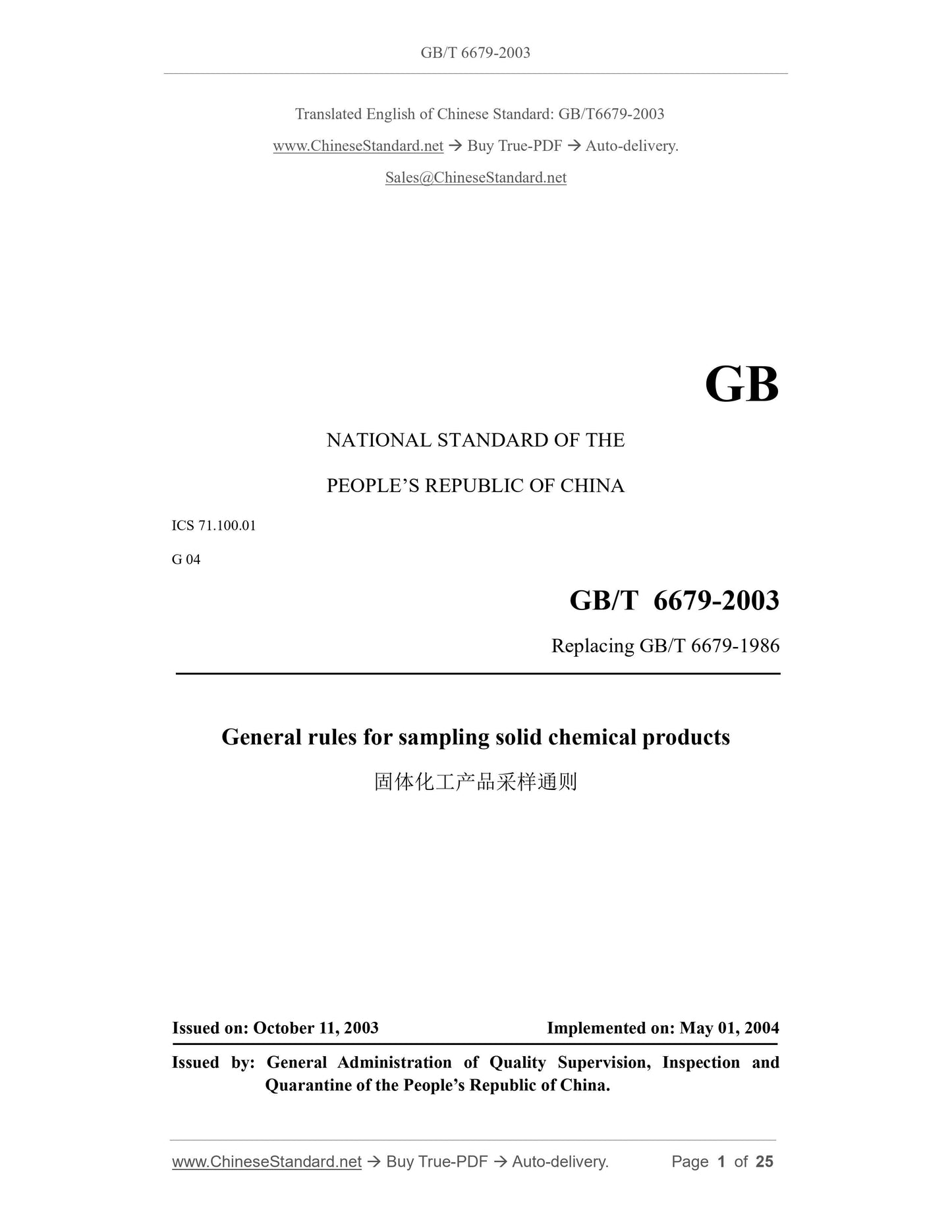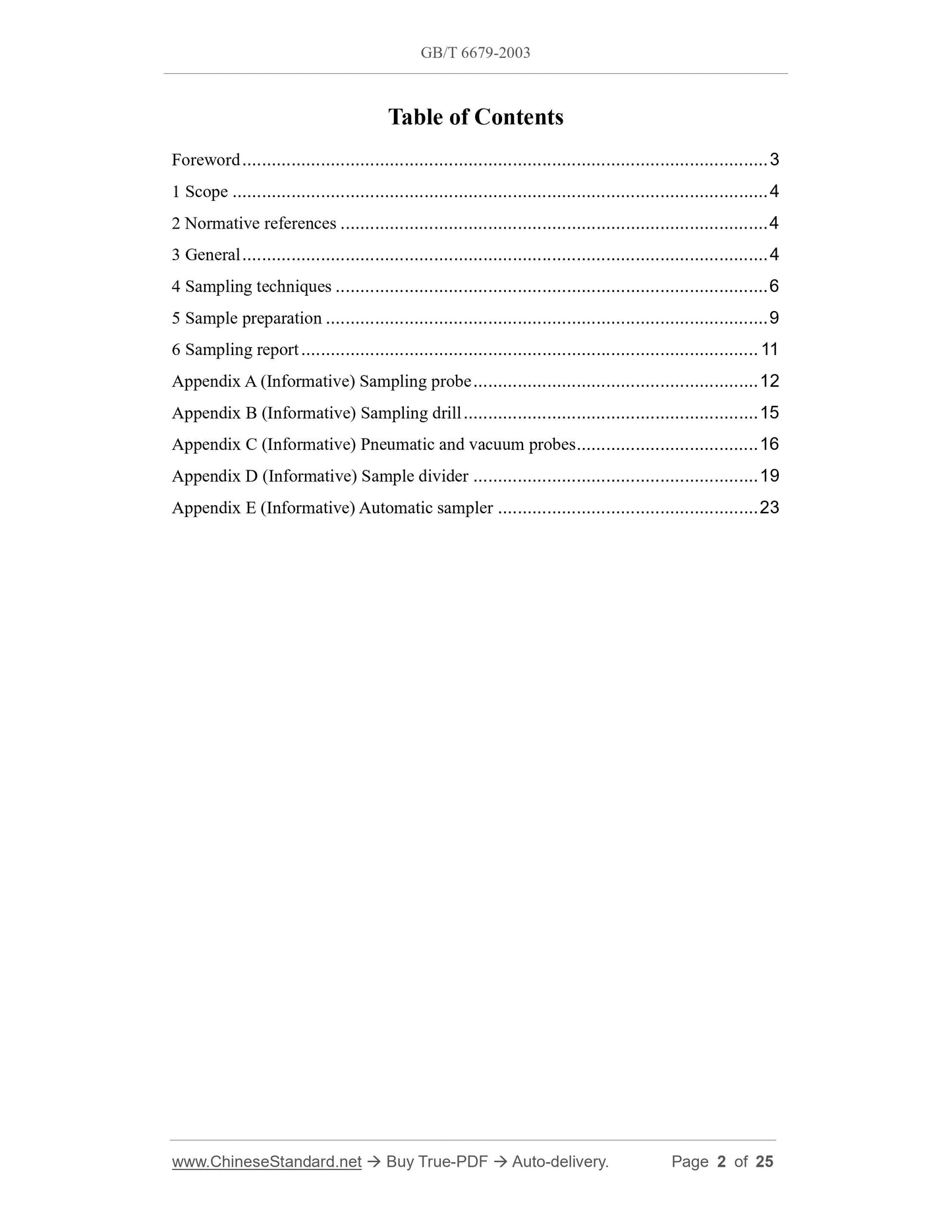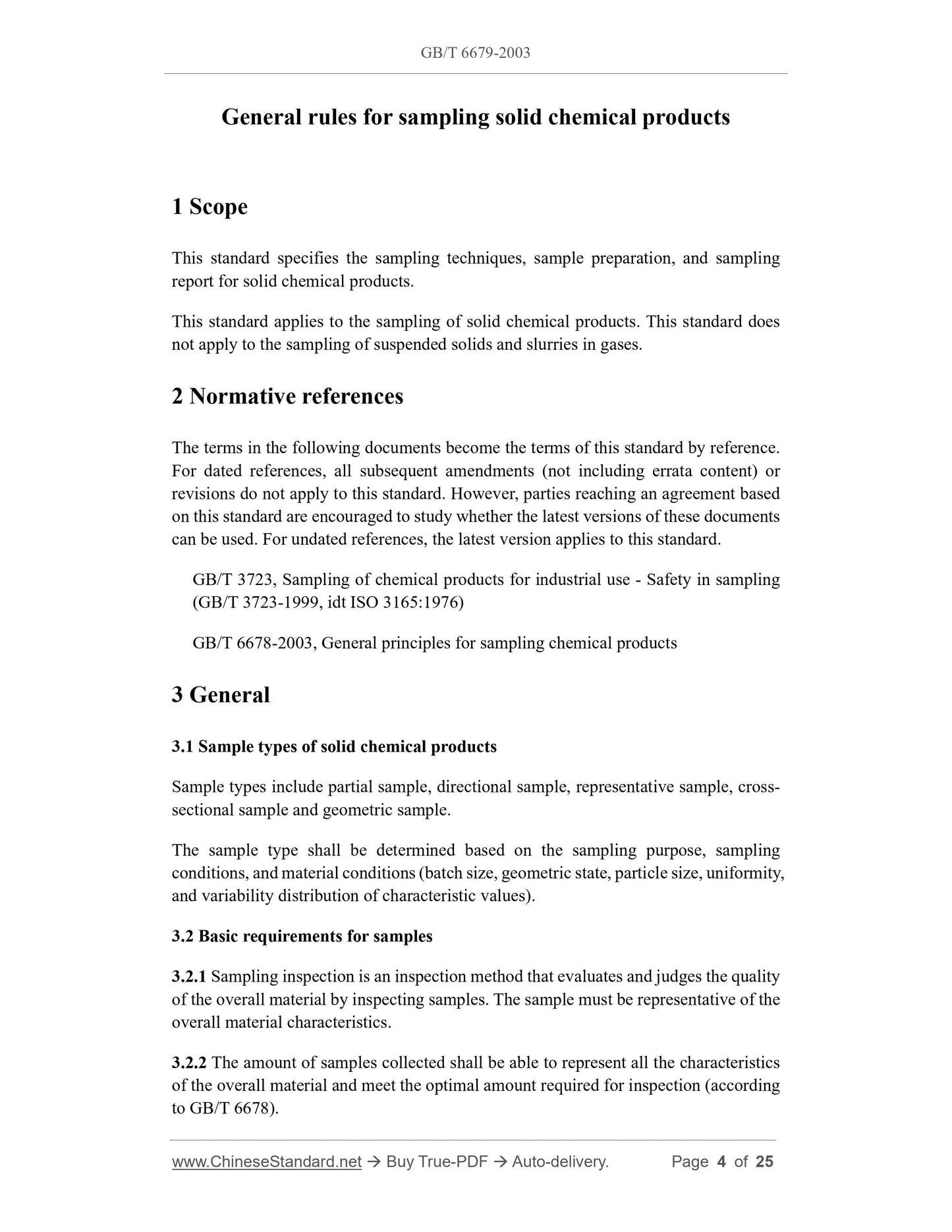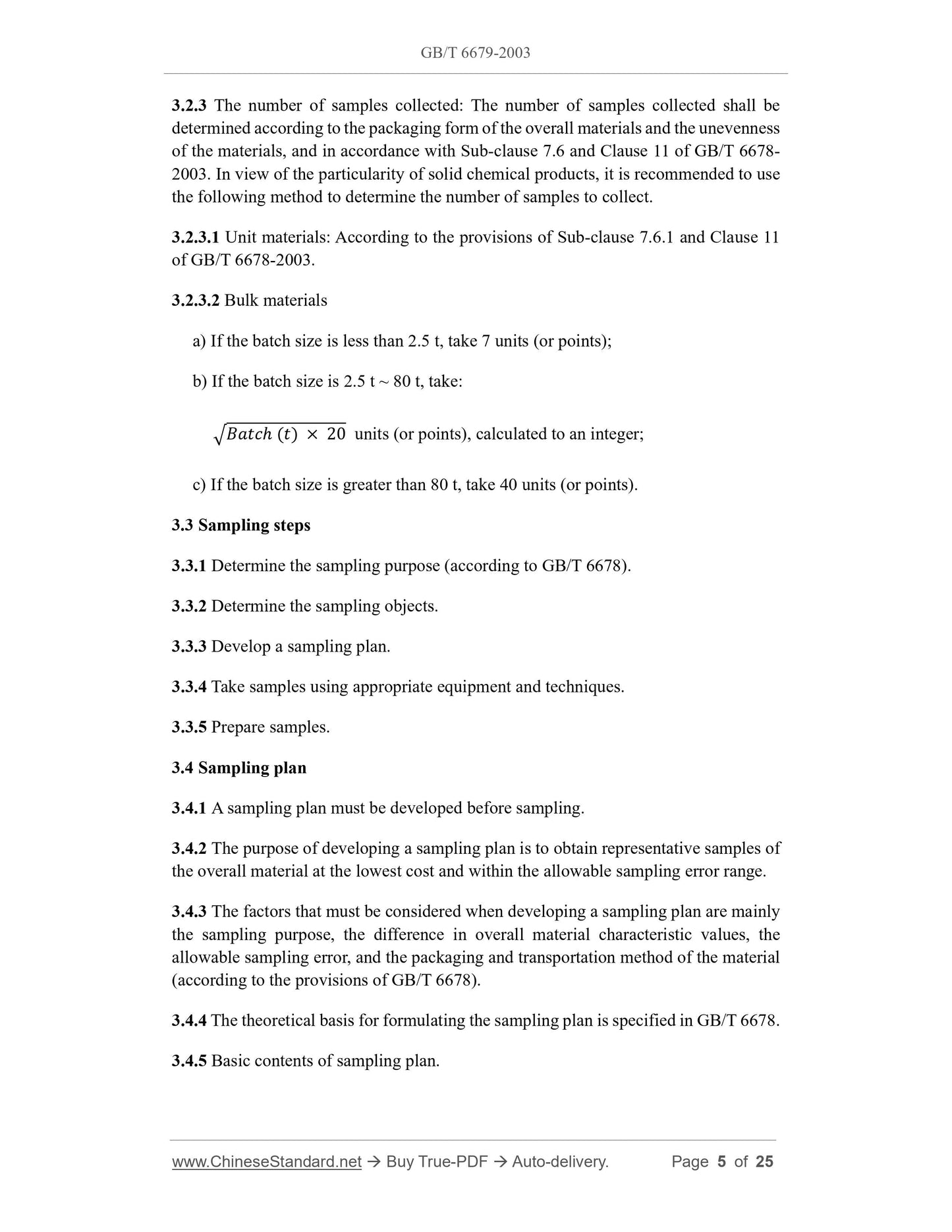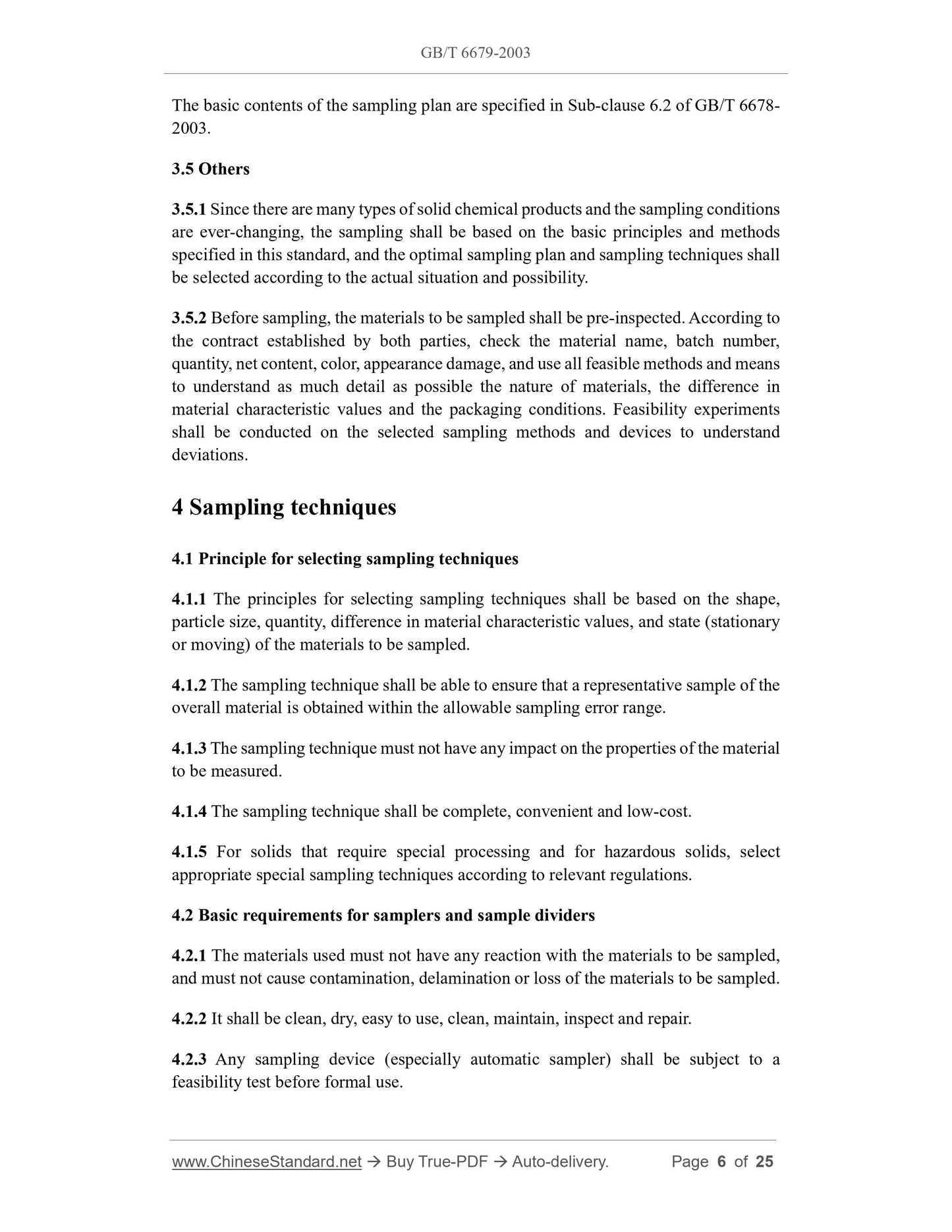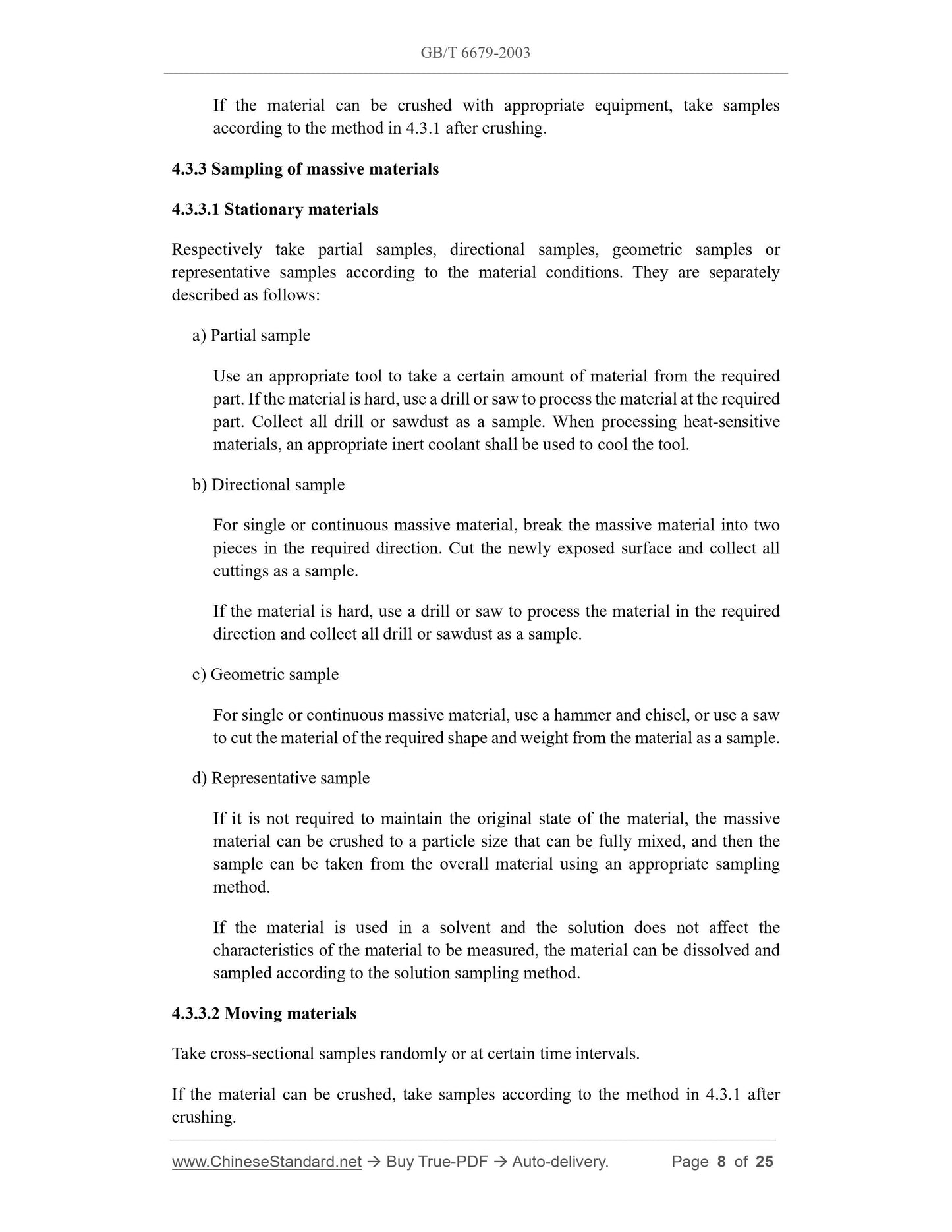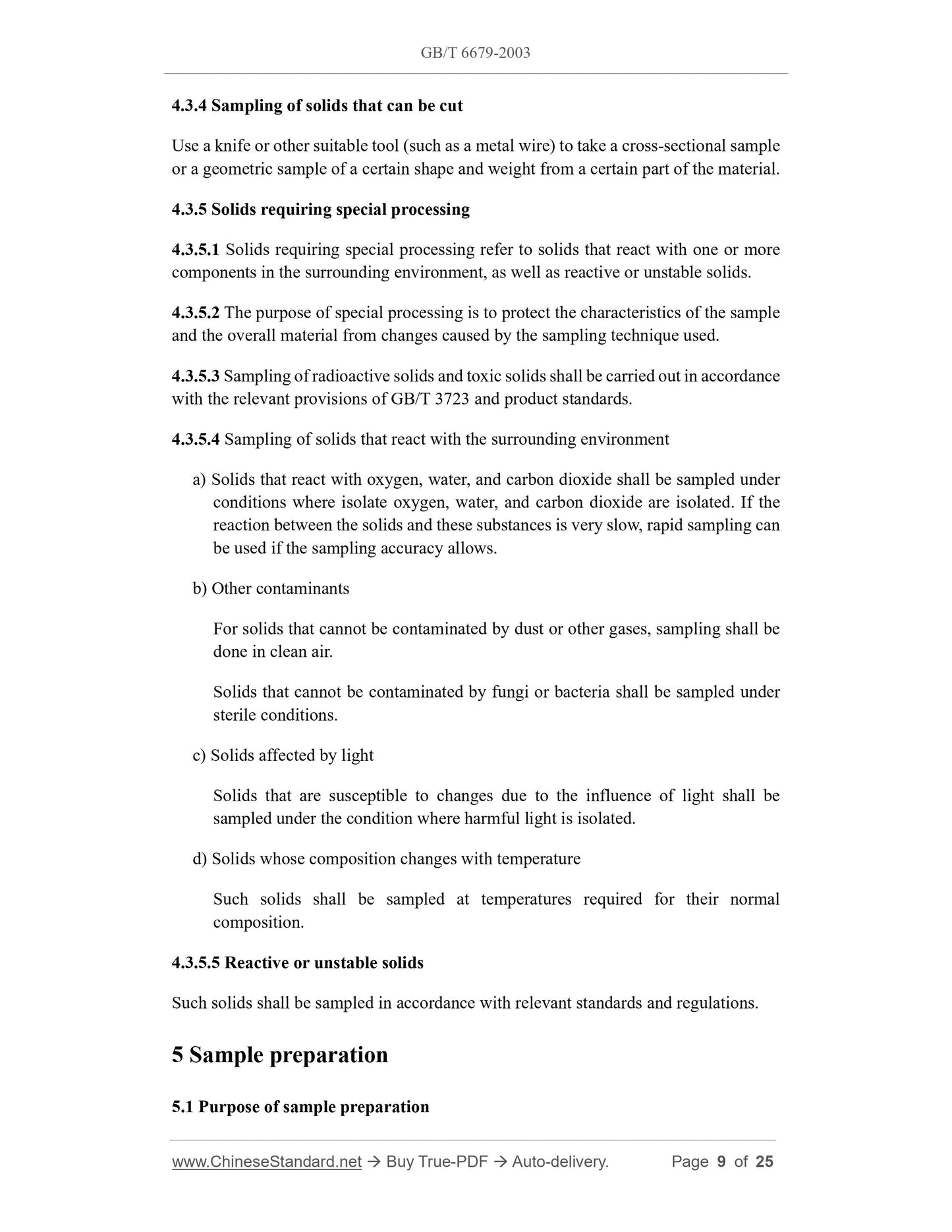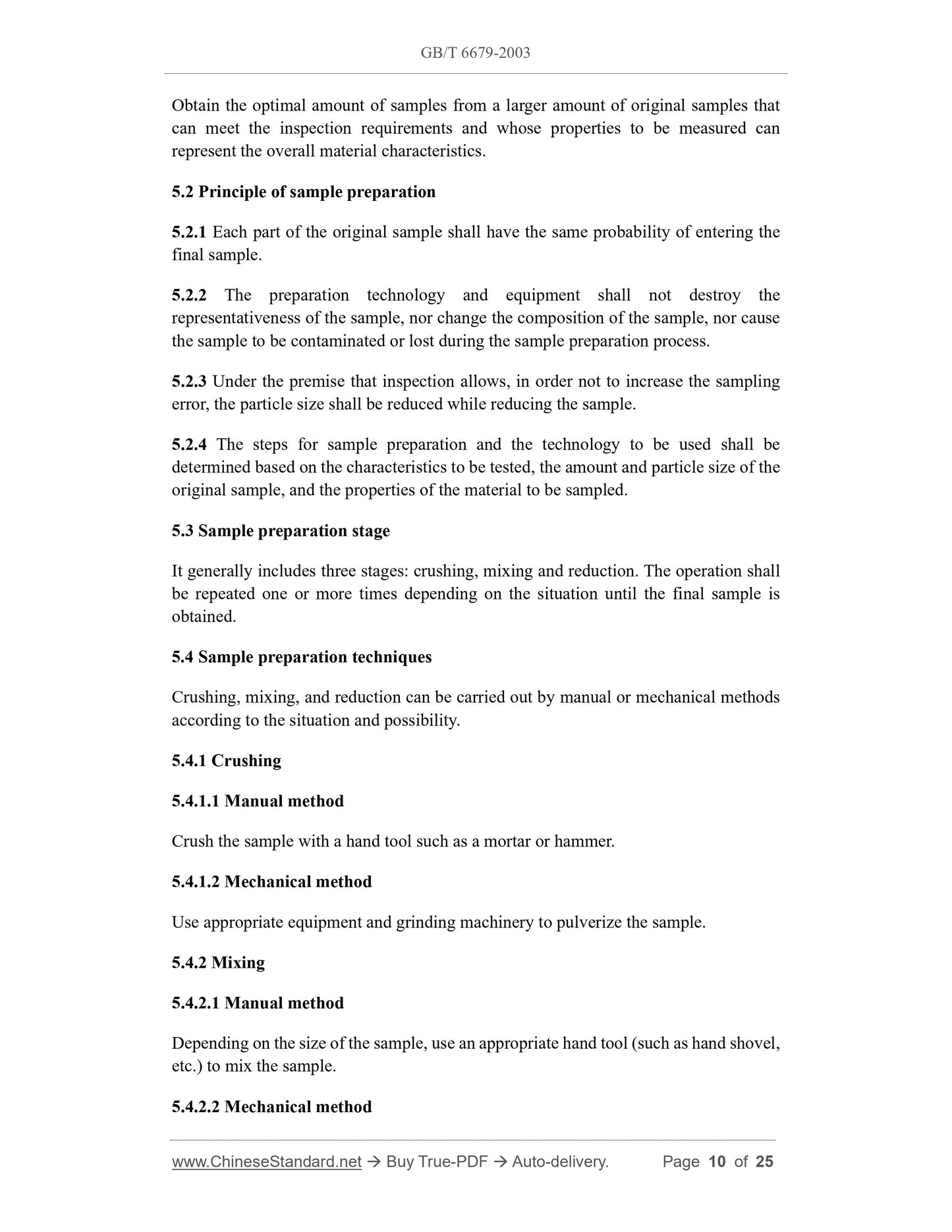1
/
of
8
www.ChineseStandard.us -- Field Test Asia Pte. Ltd.
GB/T 6679-2003 English PDF (GB/T6679-2003)
GB/T 6679-2003 English PDF (GB/T6679-2003)
Regular price
$460.00
Regular price
Sale price
$460.00
Unit price
/
per
Shipping calculated at checkout.
Couldn't load pickup availability
GB/T 6679-2003: General rules for sampling solid chemical products
Delivery: 9 seconds. Download (& Email) true-PDF + Invoice.
Get Quotation: Click GB/T 6679-2003 (Self-service in 1-minute)
Historical versions (Master-website): GB/T 6679-2003
Preview True-PDF (Reload/Scroll-down if blank)
GB/T 6679-2003
GB
NATIONAL STANDARD OF THE
PEOPLE’S REPUBLIC OF CHINA
ICS 71.100.01
G 04
Replacing GB/T 6679-1986
General rules for sampling solid chemical products
ISSUED ON: OCTOBER 11, 2003
IMPLEMENTED ON: MAY 01, 2004
Issued by: General Administration of Quality Supervision, Inspection and
Quarantine of the People’s Republic of China.
Table of Contents
Foreword ... 3
1 Scope ... 4
2 Normative references ... 4
3 General ... 4
4 Sampling techniques ... 6
5 Sample preparation ... 9
6 Sampling report ... 11
Appendix A (Informative) Sampling probe ... 12
Appendix B (Informative) Sampling drill ... 15
Appendix C (Informative) Pneumatic and vacuum probes ... 16
Appendix D (Informative) Sample divider ... 19
Appendix E (Informative) Automatic sampler ... 23
General rules for sampling solid chemical products
1 Scope
This standard specifies the sampling techniques, sample preparation, and sampling
report for solid chemical products.
This standard applies to the sampling of solid chemical products. This standard does
not apply to the sampling of suspended solids and slurries in gases.
2 Normative references
The terms in the following documents become the terms of this standard by reference.
For dated references, all subsequent amendments (not including errata content) or
revisions do not apply to this standard. However, parties reaching an agreement based
on this standard are encouraged to study whether the latest versions of these documents
can be used. For undated references, the latest version applies to this standard.
GB/T 3723, Sampling of chemical products for industrial use - Safety in sampling
(GB/T 3723-1999, idt ISO 3165:1976)
GB/T 6678-2003, General principles for sampling chemical products
3 General
3.1 Sample types of solid chemical products
Sample types include partial sample, directional sample, representative sample, cross-
sectional sample and geometric sample.
The sample type shall be determined based on the sampling purpose, sampling
conditions, and material conditions (batch size, geometric state, particle size, uniformity,
and variability distribution of characteristic values).
3.2 Basic requirements for samples
3.2.1 Sampling inspection is an inspection method that evaluates and judges the quality
of the overall material by inspecting samples. The sample must be representative of the
overall material characteristics.
3.2.2 The amount of samples collected shall be able to represent all the characteristics
of the overall material and meet the optimal amount required for inspection (according
to GB/T 6678).
3.2.3 The number of samples collected: The number of samples collected shall be
determined according to the packaging form of the overall materials and the unevenness
of the materials, and in accordance with Sub-clause 7.6 and Clause 11 of GB/T 6678-
2003. In view of the particularity of solid chemical products, it is recommended to use
the following method to determine the number of samples to collect.
3.2.3.1 Unit materials: According to the provisions of Sub-clause 7.6.1 and Clause 11
of GB/T 6678-2003.
3.2.3.2 Bulk materials
a) If the batch size is less than 2.5 t, take 7 units (or points);
b) If the batch size is 2.5 t ~ 80 t, take:
ඥ𝐵𝑎𝑡𝑐ℎ ሺ𝑡ሻ ൈ 20 units (or points), calculated to an integer;
c) If the batch size is greater than 80 t, take 40 units (or points).
3.3 Sampling steps
3.3.1 Determine the sampling purpose (according to GB/T 6678).
3.3.2 Determine the sampling objects.
3.3.3 Develop a sampling plan.
3.3.4 Take samples using appropriate equipment and techniques.
3.3.5 Prepare samples.
3.4 Sampling plan
3.4.1 A sampling plan must be developed before sampling.
3.4.2 The purpose of developing a sampling plan is to obtain representative samples of
the overall material at the lowest cost and within the allowable sampling error range.
3.4.3 The factors that must be considered when developing a sampling plan are mainly
the sampling purpose, the difference in overall material characteristic values, the
allowable sampling error, and the packaging and transportation method of the material
(according to the provisions of GB/T 6678).
3.4.4 The theoretical basis for formulating the sampling plan is specified in GB/T 6678.
3.4.5 Basic contents of sampling plan.
The basic contents of the sampling plan are specified in Sub-clause 6.2 of GB/T 6678-
2003.
3.5 Others
3.5.1 Since there are many types of solid chemical products and the sampling conditions
are ever-changing, the sampling shall be based on the basic principles and methods
specified in this standard, and the optimal sampling plan and sampling techniques shall
be selected according to the actual situation and possibility.
3.5.2 Before sampling, the materials to be sampled shall be pre-inspected. According to
the contract established by both parties, check the material name, batch number,
quantity, net content, color, appearance damage, and use all feasible methods and means
to understand as much detail as possible the nature of materials, the difference in
material characteristic values and the packaging conditions. Feasibility experiments
shall be conducted on the selected sampling methods and devices to understand
deviations.
4 Sampling techniques
4.1 Principle for selecting sampling techniques
4.1.1 The principles for selecting sampling techniques shall be based on the shape,
particle size, quantity, difference in material characteristic values, and state (stationary
or moving) of the materials to be sampled.
4.1.2 The sampling technique shall be able to ensure that a representative sample of the
overall material is obtained within the allowable sampling error range.
4.1.3 The sampling technique must not have any impact on the properties of the material
to be measured.
4.1.4 The sampling technique shall be complete, convenient and low-cost.
4.1.5 For solids that require special processing and for hazardous solids, select
appropriate special sampling techniques according to relevant regulations.
4.2 Basic requirements for samplers and sample dividers
4.2.1 The materials used must not have any reaction with the materials to be sampled,
and must not cause contamination, delamination or loss of the materials to be sampled.
4.2.2 It shall be clean, dry, easy to use, clean, maintain, inspect and repair.
4.2.3 Any sampling device (especially automatic sampler) shall be subject to a
feasibility test before formal use.
If the material can be crushed with appropriate equipment, take samples
according to the method in 4.3.1 after crushing.
4.3.3 Sampling of massive materials
4.3.3.1 Stationary materials
Respectively take partial samples, directional samples, geometric samples or
representative samples according to the material conditions. They are separately
described as follows:
a) Partial sample
Use an appropriate tool to take a certain amount of material from the required
part. If the material is hard, use a drill or saw to process the material at the required
part. Collect all drill or sawdust as a sample. When processing heat-sensitive
materials, an appropriate inert coolant shall be used to cool the tool.
b) Directional sample
For single or continuous massive material, break the massive material into two
pieces in the required direction. Cut the newly exposed surface and collect all
cuttings as a sample.
If the material is hard, use a drill or saw to process the material in the required
direction and collect all drill or sawdust as a sample.
c) Geometric sample
For single or continuous massive material, use a hammer and chisel, or use a saw
to cut the material of the required shape and weight from the material as a sample.
d) Representative sample
If it is not required to maintain the original state of the material, the massive
material can be crushed to a particle size that can be fully mixed, and then the
sample can be taken from the overall material using an appropriate sampling
method.
If the material is used in a solvent and the solution does not affect the
characteristics of the material to be measured, the material can be dissolved and
sampled according to the solution sampling method.
4.3.3.2 Moving materials
Take cross-sectional samples randomly or at certain time intervals.
If the material can be crushed, take samples according to the method in 4.3.1 after
crushing.
4.3.4 Sampling of solids that can be cut
Use a knife or other suitable tool (such as a metal wire) to take a cross-sectional sample
or a geometric sample of a certain shape and weight from a certain part of the material.
4.3.5 Solids requiring special processing
4.3.5.1 Solids requiring special processing refer to solids that react with one or more
components in the surrounding environment, as well as reactive or unstable solids.
4.3.5.2 The purpose of special processing is to protect the characteristics of the sample
and the overall material from changes caused by the sampling technique used.
4.3.5.3 Sampling of radioactive solids and toxic solids shall be carried out in accordance
with the relevant provisions of GB/T 3723 and product standards.
4.3.5.4 Sampling of solids that react with the surrounding environment
a) Solids that react with oxygen, water, and carbon dioxide shall be sampled under
conditions where isolate oxygen, water, and carbon dioxide are isolated. If the
reaction between the solids and these substances is very slow, rapid sampling can
be used if the sampling accuracy allows.
b) Other contaminants
For solids that cannot be contaminated by dust or other gases, sampling shall be
done in clean air.
Solids that cannot be contaminated by fungi or bacteria shall be sampled under
sterile conditions.
c) Solids affected by light
Solids that are susceptible to changes due to the influence of light shall be
sampled under the condition where harmful light is isolated.
d) Solids whose composition changes with temperature
Such solids shall be sampled at temperatures required for their normal
composition.
4.3.5.5 Reactive or unstable solids
Such solids shall be sampled in accordance with relevant standards and regulations.
5 Sample preparation
5.1 Purpose of sample preparation
Obtain the optimal amount of samples from a larger amount of original samples that
can meet the inspection requirements and whose properties to be measured can
represent the overall material characteristics.
5.2 Principle of sample preparation
5.2.1 Each part of the original sample shall have the same probability of entering the
final sample.
5.2.2 The preparation technology and equipment shall not destroy the
representativeness of the sample, nor change the composition of the sample, nor cause
the sample to be contaminated or lost during the sample preparation process.
5.2.3 Under the premise that inspection allows, in order not to increase the sampling
error, the particle size shall be reduced while reducing the sample.
5.2.4 The steps for sample preparation and the technology to be used shall be
determined based on the characteristics to be tested, the amount and particle size of the
original sample, and the properties of the material to be sampled.
5.3 Sample preparation stage
It generally includes three stages: crushing, mixing and reduction. The operation shall
be repeated one or more times depending on the situation until the final sample is
obtained.
5.4 Sample preparation techniques
Crushing, mixing, and reduction can be carried out by manual or mechanical methods
according to the situation and possibility.
5.4.1 Crushing
5.4.1.1 Manual method
Crush the sample with a hand tool such as a mortar or hammer.
5.4.1.2 Mechanical method
Use appropriate equipment and grinding machinery to pulverize the sample.
5.4.2 Mixing
5.4.2.1 Manual method
Depending on the size of the sample, use an appropriate hand tool (such as hand shovel,
etc.) to mix the sample.
5.4.2.2 Mechanical method
GB/T 6679-2003
GB
NATIONAL STANDARD OF THE
PEOPLE’S REPUBLIC OF CHINA
ICS 71.100.01
G 04
Replacing GB/T 6679-1986
General rules for sampling solid chemical products
ISSUED ON: OCTOBER 11, 2003
IMPLEMENTED ON: MAY 01, 2004
Issued by: General Administration of Quality Supervision, Inspection and
Quarantine of the People’s Republic of China.
Table of Contents
Foreword ... 3
1 Scope ... 4
2 Normative references ... 4
3 General ... 4
4 Sampling techniques ... 6
5 Sample preparation ... 9
6 Sampling report ... 11
Appendix A (Informative) Sampling probe ... 12
Appendix B (Informative) Sampling drill ... 15
Appendix C (Informative) Pneumatic and vacuum probes ... 16
Appendix D (Informative) Sample divider ... 19
Appendix E (Informative) Automatic sampler ... 23
General rules for sampling solid chemical products
1 Scope
This standard specifies the sampling techniques, sample preparation, and sampling
report for solid chemical products.
This standard applies to the sampling of solid chemical products. This standard does
not apply to the sampling of suspended solids and slurries in gases.
2 Normative references
The terms in the following documents become the terms of this standard by reference.
For dated references, all subsequent amendments (not including errata content) or
revisions do not apply to this standard. However, parties reaching an agreement based
on this standard are encouraged to study whether the latest versions of these documents
can be used. For undated references, the latest version applies to this standard.
GB/T 3723, Sampling of chemical products for industrial use - Safety in sampling
(GB/T 3723-1999, idt ISO 3165:1976)
GB/T 6678-2003, General principles for sampling chemical products
3 General
3.1 Sample types of solid chemical products
Sample types include partial sample, directional sample, representative sample, cross-
sectional sample and geometric sample.
The...
Delivery: 9 seconds. Download (& Email) true-PDF + Invoice.
Get Quotation: Click GB/T 6679-2003 (Self-service in 1-minute)
Historical versions (Master-website): GB/T 6679-2003
Preview True-PDF (Reload/Scroll-down if blank)
GB/T 6679-2003
GB
NATIONAL STANDARD OF THE
PEOPLE’S REPUBLIC OF CHINA
ICS 71.100.01
G 04
Replacing GB/T 6679-1986
General rules for sampling solid chemical products
ISSUED ON: OCTOBER 11, 2003
IMPLEMENTED ON: MAY 01, 2004
Issued by: General Administration of Quality Supervision, Inspection and
Quarantine of the People’s Republic of China.
Table of Contents
Foreword ... 3
1 Scope ... 4
2 Normative references ... 4
3 General ... 4
4 Sampling techniques ... 6
5 Sample preparation ... 9
6 Sampling report ... 11
Appendix A (Informative) Sampling probe ... 12
Appendix B (Informative) Sampling drill ... 15
Appendix C (Informative) Pneumatic and vacuum probes ... 16
Appendix D (Informative) Sample divider ... 19
Appendix E (Informative) Automatic sampler ... 23
General rules for sampling solid chemical products
1 Scope
This standard specifies the sampling techniques, sample preparation, and sampling
report for solid chemical products.
This standard applies to the sampling of solid chemical products. This standard does
not apply to the sampling of suspended solids and slurries in gases.
2 Normative references
The terms in the following documents become the terms of this standard by reference.
For dated references, all subsequent amendments (not including errata content) or
revisions do not apply to this standard. However, parties reaching an agreement based
on this standard are encouraged to study whether the latest versions of these documents
can be used. For undated references, the latest version applies to this standard.
GB/T 3723, Sampling of chemical products for industrial use - Safety in sampling
(GB/T 3723-1999, idt ISO 3165:1976)
GB/T 6678-2003, General principles for sampling chemical products
3 General
3.1 Sample types of solid chemical products
Sample types include partial sample, directional sample, representative sample, cross-
sectional sample and geometric sample.
The sample type shall be determined based on the sampling purpose, sampling
conditions, and material conditions (batch size, geometric state, particle size, uniformity,
and variability distribution of characteristic values).
3.2 Basic requirements for samples
3.2.1 Sampling inspection is an inspection method that evaluates and judges the quality
of the overall material by inspecting samples. The sample must be representative of the
overall material characteristics.
3.2.2 The amount of samples collected shall be able to represent all the characteristics
of the overall material and meet the optimal amount required for inspection (according
to GB/T 6678).
3.2.3 The number of samples collected: The number of samples collected shall be
determined according to the packaging form of the overall materials and the unevenness
of the materials, and in accordance with Sub-clause 7.6 and Clause 11 of GB/T 6678-
2003. In view of the particularity of solid chemical products, it is recommended to use
the following method to determine the number of samples to collect.
3.2.3.1 Unit materials: According to the provisions of Sub-clause 7.6.1 and Clause 11
of GB/T 6678-2003.
3.2.3.2 Bulk materials
a) If the batch size is less than 2.5 t, take 7 units (or points);
b) If the batch size is 2.5 t ~ 80 t, take:
ඥ𝐵𝑎𝑡𝑐ℎ ሺ𝑡ሻ ൈ 20 units (or points), calculated to an integer;
c) If the batch size is greater than 80 t, take 40 units (or points).
3.3 Sampling steps
3.3.1 Determine the sampling purpose (according to GB/T 6678).
3.3.2 Determine the sampling objects.
3.3.3 Develop a sampling plan.
3.3.4 Take samples using appropriate equipment and techniques.
3.3.5 Prepare samples.
3.4 Sampling plan
3.4.1 A sampling plan must be developed before sampling.
3.4.2 The purpose of developing a sampling plan is to obtain representative samples of
the overall material at the lowest cost and within the allowable sampling error range.
3.4.3 The factors that must be considered when developing a sampling plan are mainly
the sampling purpose, the difference in overall material characteristic values, the
allowable sampling error, and the packaging and transportation method of the material
(according to the provisions of GB/T 6678).
3.4.4 The theoretical basis for formulating the sampling plan is specified in GB/T 6678.
3.4.5 Basic contents of sampling plan.
The basic contents of the sampling plan are specified in Sub-clause 6.2 of GB/T 6678-
2003.
3.5 Others
3.5.1 Since there are many types of solid chemical products and the sampling conditions
are ever-changing, the sampling shall be based on the basic principles and methods
specified in this standard, and the optimal sampling plan and sampling techniques shall
be selected according to the actual situation and possibility.
3.5.2 Before sampling, the materials to be sampled shall be pre-inspected. According to
the contract established by both parties, check the material name, batch number,
quantity, net content, color, appearance damage, and use all feasible methods and means
to understand as much detail as possible the nature of materials, the difference in
material characteristic values and the packaging conditions. Feasibility experiments
shall be conducted on the selected sampling methods and devices to understand
deviations.
4 Sampling techniques
4.1 Principle for selecting sampling techniques
4.1.1 The principles for selecting sampling techniques shall be based on the shape,
particle size, quantity, difference in material characteristic values, and state (stationary
or moving) of the materials to be sampled.
4.1.2 The sampling technique shall be able to ensure that a representative sample of the
overall material is obtained within the allowable sampling error range.
4.1.3 The sampling technique must not have any impact on the properties of the material
to be measured.
4.1.4 The sampling technique shall be complete, convenient and low-cost.
4.1.5 For solids that require special processing and for hazardous solids, select
appropriate special sampling techniques according to relevant regulations.
4.2 Basic requirements for samplers and sample dividers
4.2.1 The materials used must not have any reaction with the materials to be sampled,
and must not cause contamination, delamination or loss of the materials to be sampled.
4.2.2 It shall be clean, dry, easy to use, clean, maintain, inspect and repair.
4.2.3 Any sampling device (especially automatic sampler) shall be subject to a
feasibility test before formal use.
If the material can be crushed with appropriate equipment, take samples
according to the method in 4.3.1 after crushing.
4.3.3 Sampling of massive materials
4.3.3.1 Stationary materials
Respectively take partial samples, directional samples, geometric samples or
representative samples according to the material conditions. They are separately
described as follows:
a) Partial sample
Use an appropriate tool to take a certain amount of material from the required
part. If the material is hard, use a drill or saw to process the material at the required
part. Collect all drill or sawdust as a sample. When processing heat-sensitive
materials, an appropriate inert coolant shall be used to cool the tool.
b) Directional sample
For single or continuous massive material, break the massive material into two
pieces in the required direction. Cut the newly exposed surface and collect all
cuttings as a sample.
If the material is hard, use a drill or saw to process the material in the required
direction and collect all drill or sawdust as a sample.
c) Geometric sample
For single or continuous massive material, use a hammer and chisel, or use a saw
to cut the material of the required shape and weight from the material as a sample.
d) Representative sample
If it is not required to maintain the original state of the material, the massive
material can be crushed to a particle size that can be fully mixed, and then the
sample can be taken from the overall material using an appropriate sampling
method.
If the material is used in a solvent and the solution does not affect the
characteristics of the material to be measured, the material can be dissolved and
sampled according to the solution sampling method.
4.3.3.2 Moving materials
Take cross-sectional samples randomly or at certain time intervals.
If the material can be crushed, take samples according to the method in 4.3.1 after
crushing.
4.3.4 Sampling of solids that can be cut
Use a knife or other suitable tool (such as a metal wire) to take a cross-sectional sample
or a geometric sample of a certain shape and weight from a certain part of the material.
4.3.5 Solids requiring special processing
4.3.5.1 Solids requiring special processing refer to solids that react with one or more
components in the surrounding environment, as well as reactive or unstable solids.
4.3.5.2 The purpose of special processing is to protect the characteristics of the sample
and the overall material from changes caused by the sampling technique used.
4.3.5.3 Sampling of radioactive solids and toxic solids shall be carried out in accordance
with the relevant provisions of GB/T 3723 and product standards.
4.3.5.4 Sampling of solids that react with the surrounding environment
a) Solids that react with oxygen, water, and carbon dioxide shall be sampled under
conditions where isolate oxygen, water, and carbon dioxide are isolated. If the
reaction between the solids and these substances is very slow, rapid sampling can
be used if the sampling accuracy allows.
b) Other contaminants
For solids that cannot be contaminated by dust or other gases, sampling shall be
done in clean air.
Solids that cannot be contaminated by fungi or bacteria shall be sampled under
sterile conditions.
c) Solids affected by light
Solids that are susceptible to changes due to the influence of light shall be
sampled under the condition where harmful light is isolated.
d) Solids whose composition changes with temperature
Such solids shall be sampled at temperatures required for their normal
composition.
4.3.5.5 Reactive or unstable solids
Such solids shall be sampled in accordance with relevant standards and regulations.
5 Sample preparation
5.1 Purpose of sample preparation
Obtain the optimal amount of samples from a larger amount of original samples that
can meet the inspection requirements and whose properties to be measured can
represent the overall material characteristics.
5.2 Principle of sample preparation
5.2.1 Each part of the original sample shall have the same probability of entering the
final sample.
5.2.2 The preparation technology and equipment shall not destroy the
representativeness of the sample, nor change the composition of the sample, nor cause
the sample to be contaminated or lost during the sample preparation process.
5.2.3 Under the premise that inspection allows, in order not to increase the sampling
error, the particle size shall be reduced while reducing the sample.
5.2.4 The steps for sample preparation and the technology to be used shall be
determined based on the characteristics to be tested, the amount and particle size of the
original sample, and the properties of the material to be sampled.
5.3 Sample preparation stage
It generally includes three stages: crushing, mixing and reduction. The operation shall
be repeated one or more times depending on the situation until the final sample is
obtained.
5.4 Sample preparation techniques
Crushing, mixing, and reduction can be carried out by manual or mechanical methods
according to the situation and possibility.
5.4.1 Crushing
5.4.1.1 Manual method
Crush the sample with a hand tool such as a mortar or hammer.
5.4.1.2 Mechanical method
Use appropriate equipment and grinding machinery to pulverize the sample.
5.4.2 Mixing
5.4.2.1 Manual method
Depending on the size of the sample, use an appropriate hand tool (such as hand shovel,
etc.) to mix the sample.
5.4.2.2 Mechanical method
GB/T 6679-2003
GB
NATIONAL STANDARD OF THE
PEOPLE’S REPUBLIC OF CHINA
ICS 71.100.01
G 04
Replacing GB/T 6679-1986
General rules for sampling solid chemical products
ISSUED ON: OCTOBER 11, 2003
IMPLEMENTED ON: MAY 01, 2004
Issued by: General Administration of Quality Supervision, Inspection and
Quarantine of the People’s Republic of China.
Table of Contents
Foreword ... 3
1 Scope ... 4
2 Normative references ... 4
3 General ... 4
4 Sampling techniques ... 6
5 Sample preparation ... 9
6 Sampling report ... 11
Appendix A (Informative) Sampling probe ... 12
Appendix B (Informative) Sampling drill ... 15
Appendix C (Informative) Pneumatic and vacuum probes ... 16
Appendix D (Informative) Sample divider ... 19
Appendix E (Informative) Automatic sampler ... 23
General rules for sampling solid chemical products
1 Scope
This standard specifies the sampling techniques, sample preparation, and sampling
report for solid chemical products.
This standard applies to the sampling of solid chemical products. This standard does
not apply to the sampling of suspended solids and slurries in gases.
2 Normative references
The terms in the following documents become the terms of this standard by reference.
For dated references, all subsequent amendments (not including errata content) or
revisions do not apply to this standard. However, parties reaching an agreement based
on this standard are encouraged to study whether the latest versions of these documents
can be used. For undated references, the latest version applies to this standard.
GB/T 3723, Sampling of chemical products for industrial use - Safety in sampling
(GB/T 3723-1999, idt ISO 3165:1976)
GB/T 6678-2003, General principles for sampling chemical products
3 General
3.1 Sample types of solid chemical products
Sample types include partial sample, directional sample, representative sample, cross-
sectional sample and geometric sample.
The...
Share
